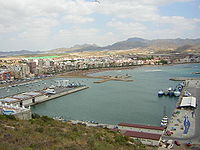
Mazarrón
Encyclopedia

Municipality
A municipality is essentially an urban administrative division having corporate status and usually powers of self-government. It can also be used to mean the governing body of a municipality. A municipality is a general-purpose administrative subdivision, as opposed to a special-purpose district...
in the autonomous community and province of Murcia
Region of Murcia
The Region of Murcia is an autonomous community of Spain located in the southeast of the country, between Andalusia and Valencian Community, on the Mediterranean coast....
, southeastern Spain
Spain
Spain , officially the Kingdom of Spain languages]] under the European Charter for Regional or Minority Languages. In each of these, Spain's official name is as follows:;;;;;;), is a country and member state of the European Union located in southwestern Europe on the Iberian Peninsula...
. The municipality has an area of 318.7 square kilometre, and a population (2008) of more than 34,351 inhabitants. A military fort (named C1 or Castillitos-small castles) built between 1930 and 1936 during the reign of Alfonso XIII of Spain
Alfonso XIII of Spain
Alfonso XIII was King of Spain from 1886 until 1931. His mother, Maria Christina of Austria, was appointed regent during his minority...
and the Second Spanish Republic
Second Spanish Republic
The Second Spanish Republic was the government of Spain between April 14 1931, and its destruction by a military rebellion, led by General Francisco Franco....
exists as a tourist attraction on the old road between Mazarrón and Cartagena
Cartagena, Spain
Cartagena is a Spanish city and a major naval station located in the Region of Murcia, by the Mediterranean coast, south-eastern Spain. As of January 2011, it has a population of 218,210 inhabitants being the Region’s second largest municipality and the country’s 6th non-Province capital...
, and although it is accessible from the Bay of Mazarrón it is not in the municipality itself.
Some of the things that must be seen:
The Bay of Mazarrón is sheltered by the last foothills of the Sierra de la Almenara, a mining area since the Carthaginian era. Over 35 km of beaches, unspoiled coves and rocky sea beds make this the ideal place for relaxing in the sun, enjoying nautical sports and scuba-diving.
The Torre de los Caballos on Los Caballos peak are just a stone's throw away, built for the towns protection against pirates from the mid-16th to the early 18th centuries.
The Bolnuevo Erosions, sandstone monuments sculpted by the water and wind, are another sight well worth seeing. Based right near the shore in Bolnuevo these are well worth the trip with many restaurants and a beautiful beach near by.
The economic development of the early 20th century led to the construction of emblematic buildings in the style known as Murcian Modernism, including the Mazarrón Town Hall and the former Cultural Athenaeum.
The great guns in Cartagena are an amazing sight. Built to defend the vital port of Cartagena in the 20th century, these guns alongside the fort and other coastal defences are a marvel into the defenses Spain went through during the early 1900s.
Standing 56 feet long, weighing a total of 88 tons each and being able to fire at a range of some 20 miles. Note: the road to this area, which passes through Campillo de Adentro, needs to be taken carefully, and the "improved" car parking facilities are in extremely poor condition.
For the more adventurous there is the monument of Jesus in Mazarron. This emblematic figure of Christ is perched right on the top of the Cabezo del faro, the highest point of the rocky cliffs which envelop Mazarron, close to the lighthouse. With great views and a nice walk this can be a day to remember.
External links
- Council of Mazarrón
- Mazarron.com
- Viva Murcia community info/photos from Murcia province

